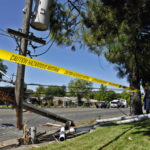The Offences of Dangerous Driving and Negligent Driving in NSW

A male on a motorbike was travelling through an intersection in the northern-Sydney suburb of Macquarie Park at around 12.20 pm on 14 February, when a 20-year-old man driving a silver SUV in the opposite direction took a righthand turn and fatally collided with the bike, throwing the rider to the ground.
An eyewitness has reported that they’d seen both vehicles enter the Epping Road intersection as the lights were changing.
Paramedics took the motorbike rider, aged in his 30s, to the Royal North Shore Hospital, where he later died, whilst the driver of the SUV was too taken to the same facility in a stable condition.
NSW police report that Ryde Area Command had established a crime scene and were investigating the matter with the Crash Investigation Unit. And upon his release from the hospital, the young SUV driver was taken to Chatswood Police Station for charging.
The SUV driver was charged with dangerous driving occasioning death and negligent driving occasioning death, and he’s to appear in court in relation to these charges on 12 March.
Dangerous driving offences are often accompanied by a second, lesser charge of negligent driving, which serves as a backup, so if the court does not convict the accused on the more serious charge, it might on the lesser.
Dangerous driving offences in New South Wales
Dangerous driving offences are the some of the most common driving offences prosecuted in the District Court of New South Wales, which is the court that deals with more serious offences, known as ‘indictable offences’.
The SUV driver involved in last week’s accident is facing one count of dangerous driving occasioning death, contrary to subsection 52A(1) of the Crimes Act 1900 (NSW), which carries a maximum penalty of 10 years imprisonment.
If the driver pleads not guilty, the prosecution will have to prove beyond a reasonable doubt that he was indeed the SUV driver, and the driver was under the influence of drugs or alcohol, or they were driving at a dangerous speed or in a manner dangerous to others.
If such an accident, causes a victim permanent or serious disfigurement, this is called grievous bodily harm.
The offence of dangerous driving occasioning grievous bodily harm sits under subsection 52A(3) and carries up to 7 years inside. The same elements that apply to the offence causing death also count for this offence.
Subsection 52A(2) contains the aggravated offence of dangerous driving occasioning death, which carries 14 years on conviction, and subsection 52A(4) holds the aggravated offence of dangerous driving occasioning grievous bodily harm, which carries up to 11 years imprisonment.
An aggravated, or more serious, dangerous driving offence has been breached when the driver has a blood alcohol reading of 0.15 or more, or was driving at a speed 45 kilometres or more above the speed limit, or trying to escape police pursuit, as well as being substantially impaired by drugs.
Negligent driving in NSW
The driver of the SUV was further charged with the traffic offence of negligent driving occasioning death, contrary to section 117 of the Road Transport Act 2013 (NSW), which also contains the other negligent driving offences.
Subsection 117(1)(a) contains the offence of negligent driving occasioning death, which carries up to 18 months prison time and/or a fine of $3,300 for a first offence, and subsequent offences carry up to 2 years in prison and/or a fine of $5,500.
In order to prove the SUV driver is guilty of committing this offence, the prosecution must show that he was driving at the time of the collision, and further, that he was not driving with the degree of care and attention that a reasonable and prudent driver would have exercised at the time.
Negligent driving occasioning grievous bodily harm appears under subsection 117(1)(b), and it carries up to 9 months inside for a first offence and/or a $2,200 fine, while a subsequent offence can make a driver liable to 12 months gaol time and/or a $3,300 fine.
The same elements to prove negligent driving occasioning death applies to occasioning grievous bodily harm, as it does to the lesser offence of negligent driving that does not occasion death or GBH, which sits under subsection 117(1)(c) and carries a fine of $1,100.
Backup charges
The Office of the Director of Public Prosecution NSW often applies a negligent driving charge as a backup to a count of dangerous driving, which can potentially be applied if the more serious offence does not stand up in court.
This is commonly referred to as a ‘backup charge’ under the law.
In New South Wales, most traffic offences are dealt with in the Local Court, while more serious traffic offences – which generally carry a maximum penalty of more than two years in prison – can be referred the District Court.
Traffic offences that constitute serious crimes that can be committed to the higher court include dangerous driving occasioning death as well as dangerous driving occasioning grievous bodily harm.
And types of driving crimes, criminal offences and traffic offences, carry various periods of licence disqualification.
Going to court?
If you find yourself required to appear in court to face a charge, call Sydney Criminal Lawyers anytime on 9261 8881 to arrange assistance from one of our experienced criminal lawyers or a traffic lawyer who will assess you’re your situation, advise you of your options and the best way forward, and fight for the optimal outcome.






